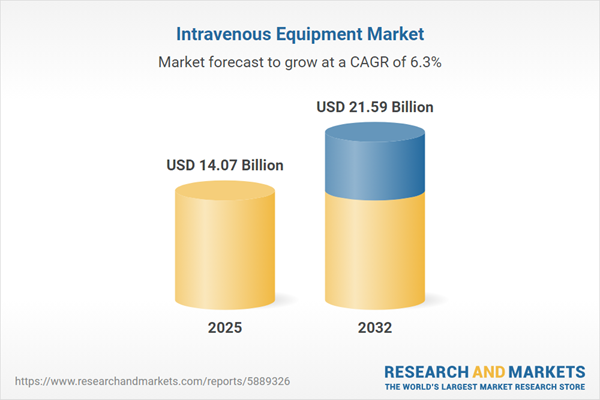Speak directly to the analyst to clarify any post sales queries you may have.
The intravenous equipment market is experiencing significant transformation as healthcare providers integrate advanced technology, adapt procurement practices, and respond to evolving regulatory demands. Senior decision-makers are positioning their organizations to benefit from increased operational efficiency and resilient care delivery models across diverse clinical environments.
Market Snapshot: Intravenous Equipment Market Growth
Growing demand for effective infusion therapy is driving steady expansion in the intravenous equipment market. As of 2024, the market is valued at USD 13.24 billion and is projected to reach USD 14.07 billion by 2025, with an anticipated climb to USD 21.59 billion by 2032. This outlines a 6.29% compound annual growth rate (CAGR) for the forecast period.
The sector’s growth is underpinned by enhanced regulatory oversight and an increasing focus on patient safety, prompting healthcare organizations to re-evaluate procurement strategies and invest in adaptable, high-quality delivery systems suitable for a range of care settings.Scope & Segmentation: Intravenous Equipment Market
This report equips senior executives with precise segmentation and actionable insights across the intravenous equipment space, enabling strategic planning and targeted resource allocation. Covered areas include:
- Product Types: Drip chambers, infusion sets, filters, winged and non-winged cannulas, catheters, and infusion pumps are essential for supporting both acute interventions and extended therapies, facilitating alignment with clinical objectives.
- End Users: Ambulatory care centers, hospitals, diagnostic facilities, outpatient clinics, and home healthcare providers each encounter specific operational requirements, influencing equipment choice and workflow optimization.
- Applications: Equipment solutions address anesthesia, nutrition therapy, oncology, pain management, and intensive care, supporting precision in fluid and medication administration across a spectrum of treatment scenarios.
- Disposable vs. Reusable: The choice between single-use and reusable devices impacts infection prevention efforts, overall cost management, and approaches to sustainability within organizational operations.
- Portability: Both portable and stationary equipment are available, supporting flexible care delivery and adapting to the needs of institutional, outpatient, and home-based settings.
- Material Types: Devices constructed from polyolefin, polyurethane, and polyvinyl chloride offer biocompatibility and facilitate regulatory approval, with material selection also affecting device durability and lifecycle considerations.
- Regions: The analysis covers the Americas, EMEA, and Asia-Pacific, with region-specific detail for the United States, Canada, Brazil, United Kingdom, Germany, China, India, Japan, Australia, and Southeast Asia to inform localized strategy.
- Companies Covered: The report profiles Becton, Dickinson and Company, Baxter International Inc., B. Braun Melsungen AG, Fresenius Kabi AG, Terumo Corporation, ICU Medical, Inc., Smiths Medical, Inc., Nipro Corporation, Shenzhen Mindray Bio-Medical Electronics Co., Ltd., and Medtronic plc, highlighting trends in technology adoption and product innovation.
Key Takeaways for Senior Decision-Makers
- Integration of digital monitoring solutions and smart infusion pumps is streamlining care workflows while enhancing multi-disciplinary collaboration throughout hospital and ambulatory care environments.
- Innovative materials are improving device durability and infection prevention, simplifying compliance processes, and directly supporting patient safety initiatives.
- Expansion of outpatient and home care is accelerating need for portable, user-centric equipment that adapts to diverse care settings and supports patient-centric delivery models.
- Collaborations between manufacturers, technology partners, and regulators are increasing digital solution adoption, improving system interoperability, and reducing compliance complexity.
- Developing resilient supply chains and agile distribution practices is helping organizations mitigate disruptions and support continuous access to vital intravenous equipment.
Tariff Impact
Recent tariffs imposed in the United States on key materials and electronics are raising production costs across the intravenous equipment sector. Leading industry participants are mitigating these effects by diversifying supplier networks and adjusting sourcing strategies. These adjustments strengthen supply chain resilience and aim to reduce the long-term influence of global trade policy changes on product availability and pricing.
Methodology & Data Sources
This report is built on interviews with senior healthcare executives and procurement leaders, along with analysis of scientific literature, regulatory documents, and third-party expertise. The combined approach ensures that insights are accurate and actionable for strategic decision planning in the intravenous equipment market.
Why This Report Matters
- Enables leadership teams to respond proactively to regulatory and industry changes, while leveraging new technologies for operational flexibility.
- Supports optimal supplier engagement and technology selection, helping advance patient care quality and institutional efficiency.
- Informs supply chain, procurement, and sustainability planning at both local and global levels.
Conclusion
Focused investment in advanced sourcing and technology prepares healthcare leaders to maintain reliable intravenous therapy while anticipating ongoing changes in clinical, regulatory, and operational landscapes.
Additional Product Information:
- Purchase of this report includes 1 year online access with quarterly updates.
- This report can be updated on request. Please contact our Customer Experience team using the Ask a Question widget on our website.
Table of Contents
3. Executive Summary
4. Market Overview
7. Cumulative Impact of Artificial Intelligence 2025
Companies Mentioned
The companies profiled in this Intravenous Equipment market report include:- Becton, Dickinson and Company
- Baxter International Inc.
- B. Braun Melsungen AG
- Fresenius Kabi AG
- Terumo Corporation
- ICU Medical, Inc.
- Smiths Medical, Inc.
- Nipro Corporation
- Shenzhen Mindray Bio-Medical Electronics Co., Ltd.
- Medtronic PLC
Table Information
| Report Attribute | Details |
|---|---|
| No. of Pages | 189 |
| Published | November 2025 |
| Forecast Period | 2025 - 2032 |
| Estimated Market Value ( USD | $ 14.07 Billion |
| Forecasted Market Value ( USD | $ 21.59 Billion |
| Compound Annual Growth Rate | 6.2% |
| Regions Covered | Global |
| No. of Companies Mentioned | 11 |









